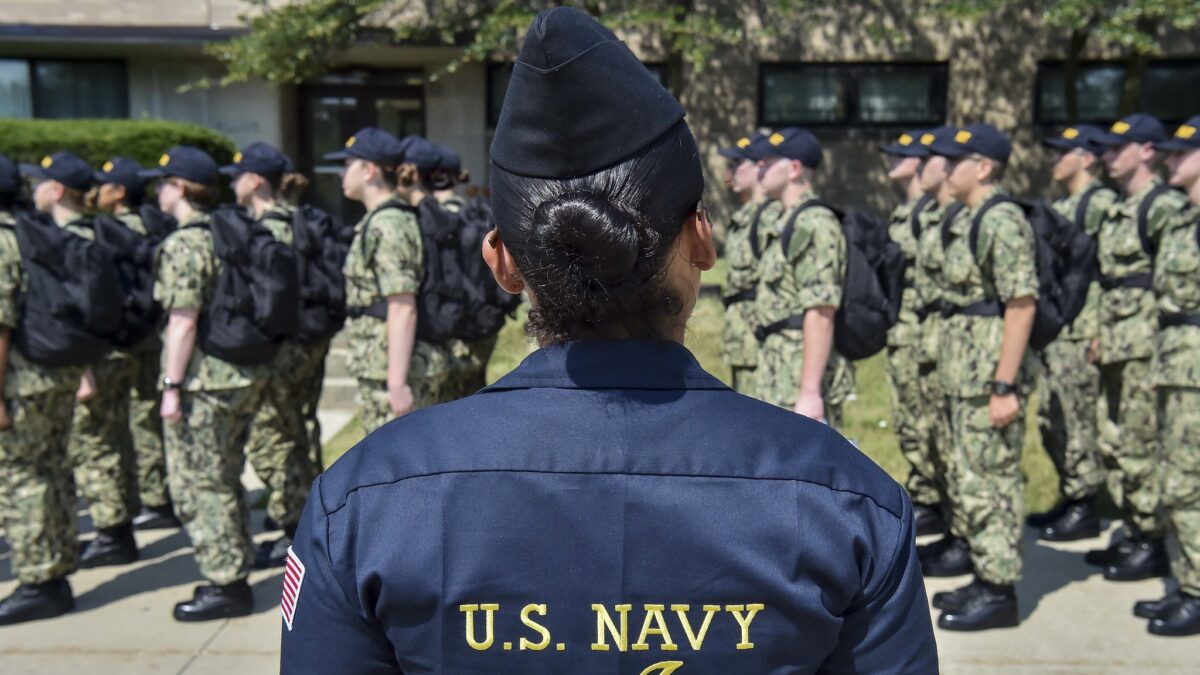Following the end of the Vietnam War and its accompanying draft, the U.S. military transformed into an all-volunteer force. In the decades that followed, the promise of good benefits, a chance for adventure, and comradery prompted swaths of Americans to give up their civilian lives to defend the freedoms of their fellow countrymen. It’s a sacrifice that has generated much-deserved respect from the nation.
But what happens when the country with the world’s most sophisticated navy no longer possesses the manpower necessary to maintain its status as a global hegemon? It’s a question the U.S. is having to grapple with as its maritime force experiences the worst personnel crisis in recent history.
In April, The Military Times reported that the Navy is expected to miss its recruiting targets for fiscal year 2023 by roughly 6,000 sailors. The news came months after it was revealed the branch failed to meet its targets for new officers and reservists for fiscal year 2022, despite meeting its active-duty enlisted recruitment goal.
To combat its ongoing personnel crisis, the Navy also increased its maximum enlistment age from 39 to 41 in November “in an effort to allow more civilians to join its ranks.” Nearly a month later, it lowered its entrance test standards. And just last month, the branch announced further plans to extend the work week for its recruiters from five days to six to address existing shortfalls but backed away from the policy after facing backlash from sailors.
The situation has gotten so bad that Navy leadership recently turned to Yeoman 2nd Class Joshua Kelley — an active-duty drag queen who goes by the stage name Harpy Daniels and identifies as non-binary — to be a “Navy Digital Ambassador.” The program — which ran from October 2022 to March 2023 — was reportedly “designed to explore the digital environment to reach a wide range of potential candidates” for military recruitment.
Potential Causes
While there’s no singular factor responsible for the Navy’s recruitment crisis, Navy veterans and policy specialists have varying ideas on why America’s maritime force is struggling to bring new sailors into service.
For Brent Sadler, a Navy veteran and senior research fellow for The Heritage Foundation’s Center for National Defense, one of the most glaring causes advancing the Navy’s personnel problems is the Biden Defense Department’s embrace of DEI ideology, which he says is alienating potential recruits from demographics that lean more conservative. DEI, which stands for “diversity, equity, and inclusion,” is a divisive and poisonous ideology dismissive of merit in order to discriminate based on characteristics such as skin color and sexual orientation.
“When you start alienating where you draw the vast majority of your recruits, you’re going to take a hit,” Sadler told The Federalist.
The embrace of DEI is “a conscious decision by this administration,” he said. “It’s going to take them a while to figure out how to actually mitigate that and if they’re going to try to broaden and diversify their recruiting. They haven’t been effective at it yet.”
In addition to its drag queen “ambassador” stint, Navy leadership also issued a memo in May 2021 outlining an action plan to promote DEI throughout the branch. The document instructed the Navy’s assistant secretary and chief diversity officer to “lead and oversee all DEI efforts across the Department to synchronize key policies and initiatives … and to develop a strategy to advance DEI across the enterprise.” Last year, the branch also published an instructional video advising service members to create a “safe space” by using “correct” pronouns.
“I do hear from veterans [who] are concerned” about these policies, Rep. Jennifer Kiggans, R-Va., told The Federalist. “When I served, I didn’t care what political ideology, what religion … what race you were. We were there working together, doing the job that our country asked us to do. That’s where the [military’s] focus needs to be.”
Kiggans — who served as a Navy helicopter pilot for 10 years and whose district includes Naval Station Norfolk — also pointed to quality-of-life issues as a potential factor contributing to the Navy’s recruitment headache. “Are we able to house our sailors properly and their families? Are we taking care of their families? What kind of health care are we providing for them? And mental health care is a big part of that,” she said.
Mental health issues, particularly suicide, among U.S. service members have been on the rise for years. An October 2022 Defense Department report shows that “suicide rates for Active Component Service members have gradually increased since 2011, although the 2021 rate [was] lower than in 2020.” A Pentagon report released earlier this month documented a similarly alarming trend for the 2023 fiscal year, with the “overall number of active-duty suicides — 94 — from January through March … up 25% compared to the number of troops — 75 — who took their own lives in the first three months of 2022.”
Solutions to Stop Sailors From Abandoning Ship
Efforts to dismantle the Pentagon’s DEI complex have already begun, as House Republicans gear up to pass their version of the National Defense Authorization Act (NDAA) for Fiscal Year 2024 before summer recess.
Among the bill’s provisions are those mandating the Pentagon use a merit-based system to determine military promotions and assignments and prohibiting the defense secretary from appointing or employing anyone, military or civilian, “with a rank or grade in excess of GS–10” to carry out DEI-related duties. Sections barring the “use of federal funds for certain training or education that promotes critical race theory,” prohibiting the use of federal money for drag shows and drag queen story hour, and cutting the position of DOD chief diversity officer, are also included.
Unsurprisingly, the White House has already expressed its opposition to the provisions, claiming in a memo to ranking members of the House Armed Services Committee the Pentagon’s use of DEI instruction “promote[s] a cohesive and inclusive force.”
Also included in the NDAA are several amendments sponsored by Kiggans derived from the “Sailor Standard of Care Act,” a bill she introduced in May that directs the secretary of the Navy to provide more mental health resources for sailors and requires the Navy to conduct mental health screenings for “each member … designated for limited duty.”
According to an office press release, provisions added to the NDAA include requirements for the Navy to “brief the House Armed Services Committee on its recommended standard operating procedures for responding to multiple suicides” and “study the feasibility of constructing and managing a dashboard to track quality of life programs and their utilization rate,” among others.
We must ensure that our military is “taken care of, and that they have the resources and tools they need to get the job done to serve the country,” Kiggans said.
Read Part 1 of The Federalist’s breakdown of the biggest problems facing the U.S. Navy here.









